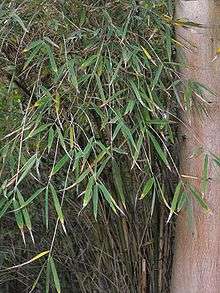Cephalostachyum
| Cephalostachyum | |
|---|---|
 | |
| Cephalostachyum pergracile | |
| Scientific classification | |
| Kingdom: | Plantae |
| Clade: | Angiosperms |
| Clade: | Monocots |
| Clade: | Commelinids |
| Order: | Poales |
| Family: | Poaceae |
| Subfamily: | Bambusoideae |
| Supertribe: | Bambusodae |
| Tribe: | Bambuseae |
| Subtribe: | Melocanninae |
| Genus: | Cephalostachyum Munro |
| Type species | |
| Cephalostachyum capitatum[1][2] | |
Cephalostachyum is a genus of Asian and Madagascan bamboo in the grass family.[3][2]
The plants are of small to medium size compared to most other bamboo. Their choice habitats are mountain to lowland forests.[4]
- Cephalostachyum burmanicum - Myanmar
- Cephalostachyum capitatum - Myanmar, Assam, Bhutan
- Cephalostachyum chapelieri - Madagascar
- Cephalostachyum flavescens - Myanmar, Andaman Islands
- Cephalostachyum langbianense - Vietnam
- Cephalostachyum latifolium - Yunnan, Myanmar, Assam, Bhutan, Nepal, Sikkim
- Cephalostachyum mannii - Yunnan, Assam, Arunachal Pradesh, Bhutan
- Cephalostachyum mindorense - Philippines
- Cephalostachyum pallidum - Yunnan, Myanmar, Assam, Tibet
- Cephalostachyum pergracile - Yunnan, Myanmar, Assam, Laos, Bhutan
- Cephalostachyum perrieri - Madagascar
- Cephalostachyum scandens - Yunnan, Myanmar
- Cephalostachyum viguieri - Madagascar
- Cephalostachyum virgatum - Yunnan, Myanmar, Laos, Vietnam
- formerly included[5]
see Bambusa Cathariostachys Dendrocalamus Kinabaluchloa Schizostachyum
- Cephalostachyum chevalieri - Kinabaluchloa wrayi
- Cephalostachyum chinense - Schizostachyum chinense
- Cephalostachyum griffithii - Schizostachyum griffithii
- Cephalostachyum madagascariense - Cathariostachys madagascariensis
- Cephalostachyum malayense - Dendrocalamus pendulus
- Cephalostachyum peclardii - Cathariostachys capitata
- Cephalostachyum pingbianense - Schizostachyum pingbianense
- Cephalostachyum sanguineum - Schizostachyum sanguineum
- Cephalostachyum schizostachyoides - Bambusa schizostachyoides
- Museums
Chinese maps show a Cephalostachyum Museum in Beijing. However, this appears to be a mistranslation; the museum is actually dedicated to the diabolo, a kind of yo-yo made of bamboo.[7]
References
- ↑ lectotype designated by McClure, Taxon 6(7): 201 (1957)
- 1 2 Tropicos, Cephalostachyum Munro
- ↑ Munro, William. 1868. Transactions of the Linnean Society of London 26(1): 138-141 descriptions in Latin, commentary in English
- ↑ Flora of China Vol. 22 Page 54 空竹属 kong zhu shu Cephalostachyum Munro, Trans. Linn. Soc. London. 26: 138. 1868.
- 1 2 Kew World Checklist of Selected Plant Families
- ↑ The Plant List search for Cephalostachyum
- ↑ Beijing's Diabolical Cephalostachyum Museum.
| Wikimedia Commons has media related to Cephalostachyum. |
| Wikispecies has information related to Cephalostachyum |
See also
This article is issued from
Wikipedia.
The text is licensed under Creative Commons - Attribution - Sharealike.
Additional terms may apply for the media files.